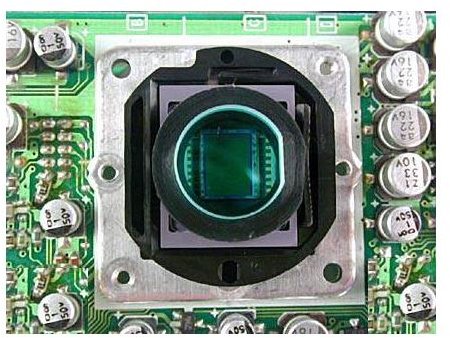Understanding a Video Camera's CCD
Genesis
There are basically two types of image sensors CCD and CMOS used in video and still cameras.
A charge-coupled device (CCD) or CMOS (complementary metal oxide semiconductor) are image sensors incorporated in a computer chip used in most video cameras. They operate like a sophisticated light sensor similar to a human eye. CCD and CMOS sensors employ similar technology.
One example would of how the light to image transfer works is to compare it to a film camera. A video camera “sees” the world through lenses. In a film camera, the lenses serve to focus the light from a scene onto film coated with chemicals that have a reaction when exposed to light.
In this way, film in the camera records the scene in minute incremental shades from light to dark: It picks up greater amounts of light from brighter parts of the scene, and lower amounts of light from darker parts of the scene.
The lens in a video camera also serves to focus light, but instead of focusing it onto film, it diverts the light onto a small semiconductor image sensor. This sensor, a charge-coupled device (CCD), the CCD is acutely sensitive to light. The image is focused on a strip of light-sensitive diodes. Depending on the type of CCD, sensors can be made up of 300,000 to 500,000 tiny light sensitive diodes. called photo sites. These cells are arranged in horizontal rows and vertical columns. Each individual diode picks up light from light to dark and converts the”image” into electronic signals. The signals are then recorded on tape or hard drive, even SD cards, as moving images.
It is interesting to note that the photo sensor elements of a CCD and CMOS sensors respond to light in a fairly wide range of wavelengths. In other words, they can`t distinguish between colours. So a basic CCD sensor forms what is essentially a B&W (black and white) video image.
Typical CCD chip
Not all video cameras were created equal
Most CCD colour cameras using a single chip system commonly used in most low cost video cameras, camcorders and digital still cameras have tiny strips of colour filter material which is laid on the top of the CCD, covering the sensor columns in a repeating green-red-blue sequence. This restricts each column of sensor elements to responding primarily colours passed by that filter, so that the video signal that emerges from the CCD sensor has colour information encoded then conveyed to the camera/recorder.
Professional or high end video cameras used in broadcast television employ three separate CCD sensors each responding to the primary colours of Red Green and Blue this process offers greater image resolution and colour saturation.
New camcorders emerging on the market are now using CMOS sensors (complementary metal oxide semiconductor). While CMOS and CCD both have unique properties that make each one suitable for different video applications, there are unique characteristics to each that need to be understood in order for a user to know whether a CMOS or CCD camera is more appropriate for the type of video production being undertaken. Generally CMOS is used in low end low power video and still or video cameras requiring surveillance tasks. Neither sensor type is superior to the other, although vendors selling only one technology have mostly claimed otherwise. However both CCD and CMOS sensors are used in high end video and still cameras.
